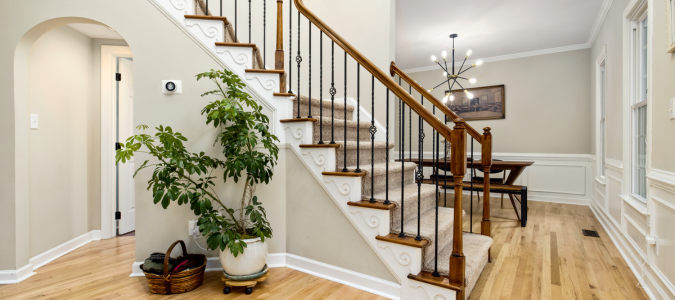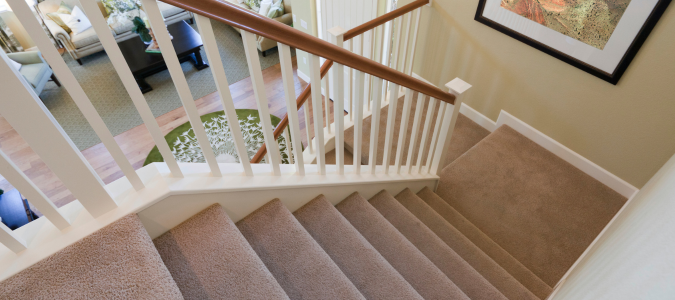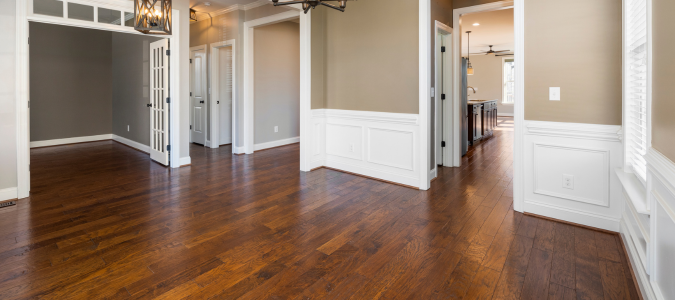Squeaky stairs are a nuisance. Besides disrupting the peace during quiet moments at home, they indicate that your stairs need maintenance. Thankfully, fixing them typically isn’t hard. It may be as simple as a loose tread, worn wedges or protruding nails. Understanding the cause of the noise is the first step to a quiet staircase.
Identify the Source of the Squeak
Before you can fix the noise in your stairs, you need to know what’s causing it. Start by enlisting the help of a friend or family member and follow these steps.
Pinpoint the Problem Area
Have someone walk up and down the stairs while you listen for creaks. Focus on the exact steps or joints making noise. Stand at the center of the stairs and gently rock side to side, followed by front to back.
If the squeak comes from the front of the stairs, the tread has come loose from the riser. If the noise comes from the back or side of the stair, the tread has come loose from the stringer.
Inspect Common Culprits
Some common reasons why your stairs may be squeaking include:
- Loose joints: Check for gaps between the treads and risers or stringers.
- Protruding nails: Ensure no nails rub against the stairs, as they can cause irritating sounds.
- Worn wedges: Over time, wooden wedges underneath stairs can weaken, which may squeak when someone steps on them.
- Structural gaps: Age or frequent use can create gaps in the staircase frame. This can cause irritating sounds when walking on the stairs.
Identifying the source of the squeak ensures that you’re targeting the right area and not wasting time on good parts of the stairs.
If your staircase is old or you don’t want to deal with squeaky stairs on your own, contact an experienced handyman to help you with the problem. You can also ask them other renovation questions, such as how to power wash a deck and other surfaces.
Simple DIY Fixes
Not every problem requires a professional’s attention. Sometimes, repairing a squeaky staircase is a simple exercise you can do with a few common tools and supplies. Here are simple solutions you can try.
Secure Loose Joints
Over time, the joints in a staircase loosen, causing a squeaking sound when you step on them. This is especially common in older homes with stairs built using nails and screws without the glue. To secure loose joints, follow these steps:
- Have someone press the stairs to compress the wood and bring the edges closer together.
- Drill two or three evenly spaced pilot holes.
- Insert a screw into the pilot holes and tighten the two parts of the stairs together. If the noise comes from the front, use the screw to tighten the tread to the riser. If it’s from the back or side, the screw will tighten the tread to the stringer. Don’t over tighten the screws, as this can lead the wood to split.
- Ensure you sink the screw slightly below the tread level. This will ensure that nobody knocks their feet on a protruding screw head while using the stairs.
- Use wood filler to cover the screw hole for a more professional look.
Replace or Reinforce Wedges
If you can access the bottom of your stairs, then wedges, or glue blocks, are excellent reinforcements. Here’s how:
- You can cut small triangular wedges to fit between the tread and riser or buy premade ones at the home improvement store.
- Apply glue to the wedges.
- Push the wedges into the right angles of the riser or tread, ensuring a tight fit.
- For added strength, drive screws into the wedges to secure them to the stair.
Use Lubricants
Lubricants can reduce squeaking noises caused by the friction of moving parts. Powdered graphite or talcum powder are good options for this job.
To apply lubricant, follow these steps:
- Select a lubricant. Avoid oil-based ones as they can cause the wood to warp.
- Wedge a piece of paper where you see a gap in the stair assembly and pour in the lubricant.
- Push the lubricant into the gap using a brush or your finger.
Remove Protruding Nails
Protruding nails are another reason stairs squeak as they rub against wood surfaces. For protruding nails, either hammer them into the stair or replace them with screws, which last longer. Alternatively, use finishing nails to secure smaller sections of the stairs and prevent movement.
If none of these solutions work, hire a professional handyman with experience in stair repairs. You can also ask them about the best interior paint ideas for your home.
Does Carpet Make Stairs Quieter?
Carpets can reduce noise on stairs for a peaceful home environment. Incorporating padding further enhances noise cancellation and the comfort of your stairs.
How Carpets Help Reduce Noise on Stairs
Carpets boast several features that make them perfect for reducing noise on stairs.
- Absorbing sound: Carpets are made of thick materials that trap sound in air pockets and fibers, reducing the distance sound can travel, thus reducing noise on the stairs.
- Additional padding: Combining carpet and padding further improves noise reduction on stairs. Padding offers a sound absorption layer that softens the impact of footsteps on wooden stairs.
Additional Benefits
Carpets on stairs offer additional benefits, including the following:
- Improved safety: Carpeted stairs can be safer. Their soft texture reduces the risk of slipping and falling by providing a better grip.
- Enhance aesthetics: Carpets are beautiful and can improve your home’s decor. You can choose different carpet designs to match the tone of your home.
- Improved comfort: Carpets offer insulation, especially during colder months. This makes using stairs easier.
Installation Tips
Carpet is a great addition to your stairs only when correctly installed. Before installing a carpet, ensure your stairs don’t have structural issues, such as loose or rotting wooden pieces. Check for loose joints, missing nails or broken pieces. This is important to ensure the carpet fits properly and is good at sound absorption.
Next, choose a durable, high-quality carpet that can withstand heavy foot traffic. Stairs are heavily used, and a poor-quality carpet will rip quickly.
Finally, consider the carpet’s thickness. While a plush carpet may work in a bedroom, it’s unsuitable for stairs as it can cause accidents. For your stairs, opt for a medium-thickness carpet with just the right amount of comfort and grip.
If you plan to carpet your stairs, hire a handyman to ensure the job is done correctly. The handyman can also help with other renovation queries, such as “what to know about replacing the siding of a house.”
Why Do My Floors Squeak When I Walk on Them?
Squeaky floors are common, especially in old homes with floorboards. They are quite annoying and are caused by different things, including the following:
- Poor subfloor installation: When subfloor panels are unevenly placed or loosely installed, they can rub against the floor’s fittings, causing a squeaking sound.
- Loose screws and nails: Over time, screws and nails used in the floor construction loosen. This causes the floor panels to shift from their original position and rub against each other.
- Uneven floor joist: If the joists aren’t perfectly level or aligned, they will cause the floor to bend, leading to instability and squeaks.
- Changes in temperature and humidity: Heat and moisture directly affect wood as a natural product. Seasonal changes in temperature and humidity can cause wooden floors to expand or contract, leading to creaks.
- Old floor materials: Over time, floorboards dry out due to age or get damaged. This is another major reason why floors squeak.
How to Fix Squeaky Floors
Squeaky floors, like squeaky stairs, can be repaired. However, before starting the repairs, it’s important to understand the cause of the noise.
Someone can walk on the floor to help you identify which floorboard is making the squeaking sound. Once you’ve identified the source of the sound, you can try the following DIY solutions:
- Tighten floorboards to the subfloor using screws. This ensures the floor panels don’t move and stay fixed longer since screws are better than nails.
- Fix wooden shims in the gap between the subfloor and the joist to prevent the floor from moving. Apply adhesive to the shims for added strength.
- Use lubricants like talcum powder or powdered graphite between floorboards to reduce friction and squeaking.
- Apply construction adhesive to smaller gaps in the floor. This prevents movement, reducing floor noises.
- Replace or repair cracked or split floorboards. If you don’t have a replacement, use a wood filler as a temporary fit.
Some homeowners can do these minor repairs yourself, but a professional is your best bet.
Let the Pros to Fix Your Squeaky Stairs
Fixing squeaky stairs is simple, but sometimes, the situation is more complicated. When that happens, it is best to engage a professional. An expert handyman will find the cause of the creaking stairs and do the necessary repairs.
ABC Can Help with Squeaky Stairs
It can be time consuming and frustrating to deal with squeaky stairs. That’s why it’s best to let a professional handyman take over. ABC’s skilled professional handymen can troubleshoot why your stairs are squeaking and perform any necessary repairs as you sit back and relax. They can even help you with other home projects, like cleaning gutters from the ground.



